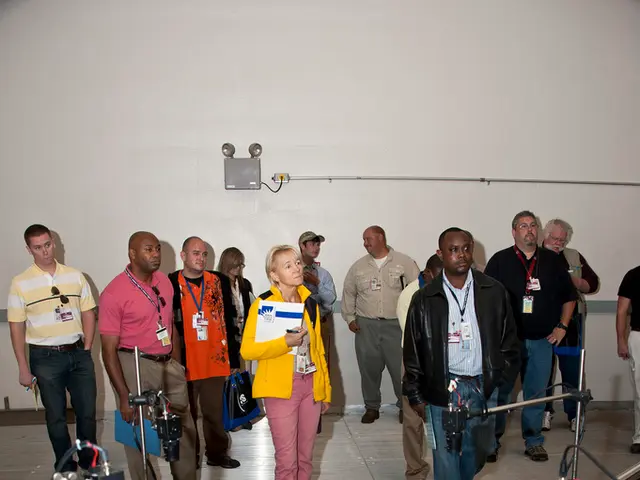Conflict Phases and Successful Conflict Resolution Approaches
Navigating Workplace Conflicts: A Guide to Resolving Disagreements Constructively
Conflict in the workplace can sometimes feel like an insurmountable obstacle, but it doesn't have to be. By recognizing and addressing conflicts at their early stages, teams can cultivate a harmonious and productive environment. Let's explore the five stages of conflict and learn practical strategies for managing them effectively.
The Latent Stage: Detecting the Early Signs
Latent conflicts brew beneath the surface, often hidden from view. Identifying these underlying issues before they escalate is crucial for avoiding unnecessary disruptions. Some early signs to watch out for include tense environments, sudden silences, increased avoidance, subtle expressions of irritation, and a general sense of unease among team members.
Addressing Issues Head-On
When you spot signs of latent conflict, it's essential to tackle them promptly. Begin by trusting your intuition, as that initial feeling of unease is often your gut telling you something is amiss. Next, engage in open communication, actively listen to concerns, and foster supportive dialogue. Approaching issues proactively can help nip potential conflicts in the bud and prevent them from escalating.
The Perceived Stage: Recognizing a Problem
As tensions simmer, conflicts may emerge at the perceived stage. At this point, symptoms may become more evident, such as avoidance, gossip, and decreased productivity. To address perceived conflicts, it is vital to recognize them early and promote understanding and empathy between team members. Encourage dialogue, practice active listening, and work together to find solutions that benefit everyone.
Boosting Emotional Intelligence: The Key to Success
Developing emotional intelligence — the ability to recognize, understand, and manage emotions — can significantly improve one's conflict management skills. By cultivating self-awareness, adopting the mindset of another, managing emotions effectively, and actively listening, team members can better navigate their way through tricky situations.
Your Call to Action
This week, pay attention to the atmosphere within your team. Are there subtle signs of conflict lurking beneath the surface? If you notice any warning signs, don't hesitate to start a conversation with a colleague or team member. By addressing conflicts promptly and reframing disagreement as an opportunity for growth, you can help create a more unified and productive work environment.
The Felt Stage: Emotions Run High
In the felt stage of conflict, emotions run deep. Feelings such as anger, hurt, and fear may surface, making it difficult to approach the issue calmly. However, it is essential to recognize these feelings and respond appropriately. Strategies for managing one's emotions during conflicts include taking deep breaths, counting to ten before responding, writing down feelings, and going for a quick walk to clear the mind.
Creating a Safe Space for Open Communication
An environment that fosters open dialogue and encourages respectful discourse is essential during conflicts. Encourage team members to express themselves openly, without fear of judgment or retaliation. Using empowering language such as "we" instead of "you," and focusing on shared goals can help create a supportive atmosphere that encourages teamwork and productive problem-solving.
The Manifest Stage: Open Disputes
As conflicts progress, they may manifest in overt disagreements. At this stage, it is vital to address the issue head-on, focusing on finding mutually beneficial solutions. Strategies for resolving actual conflicts include using an impartial mediator, compromising when possible, focusing on the future, and celebrating small wins along the way.
The Aftermath: Moving Forward
Conflicts can leave lasting effects, but they also present opportunities for growth and improvement. After a disagreement, it is essential to learn from the experience, address any oversights, and make adjustments to prevent similar conflicts from occurring in the future. By addressing conflicts constructively, team members can build trust, strengthen relationships, and improve overall communication.
In Conclusion
Conflict is a natural part of life, but it doesn't have to be detrimental to a team's success. By understanding the five stages of conflict and employing effective strategies for addressing them, teams can leverage disagreements as opportunities for growth and strengthen their collaborative bonds. Approach conflicts with an open mind, and remember that constructive dialogue is the key to building a harmonious and productive workplace.
FAQ
Q: What are the five stages of conflict?
A: The five stages of conflict are Latent, Perceived, Felt, Manifest, and the Aftermath.
Q: How can recognizing the stages of conflict improve conflict management?
A: Identifying the stage of a conflict allows individuals to apply the most appropriate strategies for resolving it effectively. Early identification prevents disputes from escalating and fosters a more cohesive and productive work environment.
[1]: Research shows that collaborative problem-solving is more effective than either party pursuing their interests competitively. Collaborative interactions lead to greater satisfaction, are less stressful, and result in more creative solutions.
[3]: By addressing the underlying causes of conflict, such as workload or resource management, organizations can create an environment that is more conducive to productivity and collaboration.
[4]: Promoting respect and civility in the workplace reduces the likelihood of conflicts arising from incivility. A culture of respect encourages open dialogue and fosters a healthier work environment for all employees.
- The latent stage of conflict often involves early signs such as tense environments, sudden silences, increased avoidance, subtle expressions of irritation, and a general sense of unease among team members, which can be crucial to address promptly for a harmonious and productive environment.
- Developing emotional intelligence can significantly improve conflict management skills, allowing team members to better navigate conflicts by recognizing, understanding, and managing emotions effectively.
- In the felt stage of conflict, emotions such as anger, hurt, and fear may surface, making it difficult to approach the issue calmly. To manage these emotions, strategies like taking deep breaths, counting to ten before responding, writing down feelings, and going for a quick walk to clear the mind can be helpful.
- A safe space for open communication, encouraging respectful dialogue and promoting understanding and empathy between team members, is essential for addressing perceived conflicts early.
- By employing strategies like using an impartial mediator, compromising when possible, focusing on shared goals, and celebrating small wins along the way, conflicts at the manifest stage can be resolved effectively.
- Constructive dialogue, fostering an environment that promotes strong communication skills, problem-solving, emotional intelligence, influence, leadership, and workplace-wellness can lead to a healthier work environment, increased productivity, and better financial outcomes for the business.







